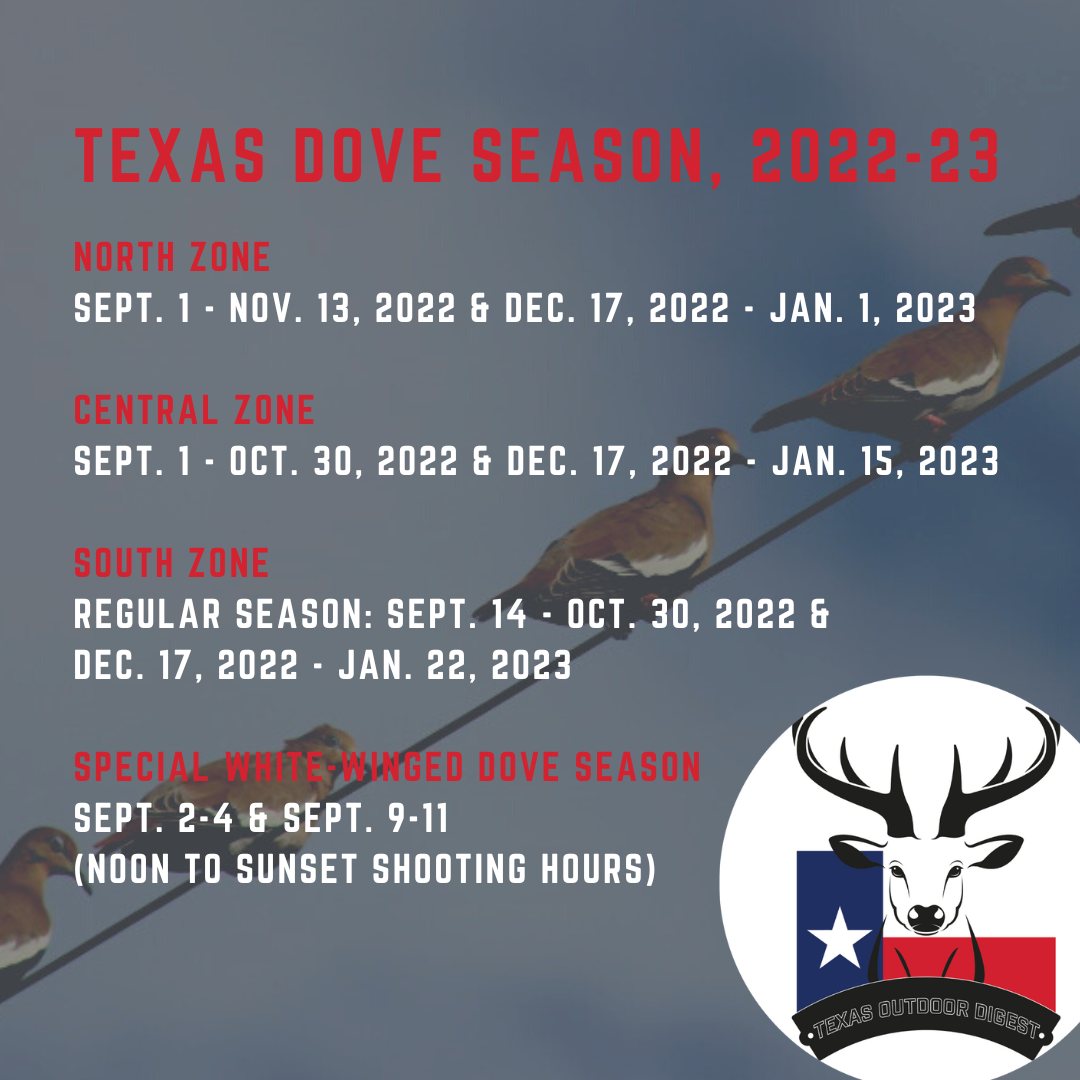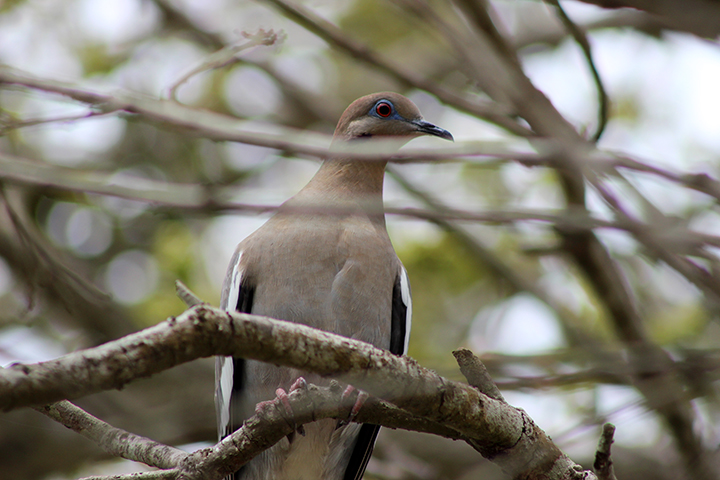
The most dangerous game in Texas doesn’t have menacing claws, sweeping tusks or broad headgear.
It isn’t a predator, it isn’t a carnivore, and in fact, it doesn’t even have teeth.
It’s a 5-ounce bird (give or take, based on what species you’re hunting — mourning doves, whitewings or Eurasian collared doves).
Dove hunting again was the most hazardous outdoors pursuit in Texas in 2021, and it’s a good bet it again will keep that title in 2022-23 frameworks as hundreds of thousands of hunters will pursue mourning doves, white-winged doves and Eurasians from the Panhandle to the Mexican border.
Dove hunting offers a number of dangers, chiefly the inherent risk that comes with the proximity of hunters armed with weapons capable of inflicting serious damage — even out to distances that many may consider relatively safe from bird shot.
Doves also provide the first entry back into hunting seasons for hundreds of thousands of hunters annually, which in itself can be hazardous. Many hunters undoubtedly never check their shotguns or shotgun shells before heading out to shoot at birds, which is a major cause for concern simply because of what could happen. You’d be surprised how many accidents are caused by faulty gear — including guns and ammo — or by obstructions that some hunters never knew were there.
It’s always good practice to fully inspect your gear from top to bottom and inside to out for anything that could pose a hazard. In the case of doves, it’s also never a bad idea to take the shotgun you’re planning to use out to dust some clays in advance of a much tougher target. First of all, it’s a safety issue, but perhaps more importantly, you don’t want your buddies to get a hearty laugh at your expense whenever possible if your shotgunning isn’t up to par and you’re missing easy shots.
According to Texas Parks and Wildlife Department data, there were 1,239,466 hunting licenses sold in 2021 and 12 firearm-related hunting accidents (an all-time low), including one fatal incident. That was the third time in the past 55 years since TPWD has documented hunting accident data that there has been just one human death involving hunting in the state.
Of that overall total, six accidents were reported by dove hunters, the most for any species. Hunting for feral hogs/javelinas and pheasants/quail contributed to two accidents, the second-most, and all were non-fatal.
This past year, there were no fatal accidents involving dove hunting. However, the numerous incidents involving shotgun-related injuries while dove hunting all center on a common theme: a hunter tracking a bird with their shotgun and swinging the barrel into what is considered outside a safe zone of fire. This is far and away the most frequent danger in any bird hunting scenario, but it’s one that easily is avoidable.
Here are the non-fatal dove-hunting accidents from 2021-22 frameworks as follows, taken directly from TPWD reports:
- Multiple shooters were firing at low-flying doves while victim was in sunflower field retrieving a downed bird. Victim, about 50 yards away from the group of shooters, was struck by 17 pellets to face, arm and torso. Game warden received account only from victim who did not know who from the group shot in his direction.
- Shooter fired at low-flying doves outside of his safe zone and peppered one of his hunting companions who had repositioned himself to another side of a pond about 25-35 yards away. Victim was struck by pellets to head and upper torso.
- While changing shot tubes in the muzzle of his shotgun, shooter carelessly discharged his loaded shotgun and sent the blast of pellets through his hand.
- Shooter fired on low-flying dove outside of his safe zone and peppered his hunting companion who had left, then returned to the hunting location.
- Shooter fired on low-flying dove outside of his safe zone and peppered his hunting companion who was 20 yards away and bent over, retrieving a downed bird. Victim was hit by pellets in the back, arm, neck, and head.
- Shooter fired at low-flying doves outside of his safe zone and peppered one of his hunting companions who was on the other side of a pond. Victim was struck by pellets to arm, shoulder, hand and lip.
It’s almost effortless to get caught up in the heat of the moment when a streak of feathers springs up out of nowhere, whether it be doves in September, quail in November or pheasants in December. However, knowing where others are, including dogs, is paramount to safety.
A couple of decades ago in Brown County, a varied group was out quail hunting and a simple twist of fate meant the difference between life and death for a young hunter whose only mistake was being in the wrong place at the wrong time. After a couple of pointers locked in on a covey in a thick clump of brush and grass, the four-hunter party cautiously approached with their scatterguns at the ready. Within steps of a young pup and a seasoned furry tracker the quail blasted out in all directions, fluttering low and fast as they typically do. An instant later, barrels barked, and a few birds dropped.
But so did a youngster on his first hunt, hit in the chest at about 40 yards with a wad of No. 8 shot. Luckily for him, one of his hunting partners that day was a doctor. Even luckier, the old man was willing to massage his heart to keep it beating.
If he hadn’t been there, the boy wouldn’t have left the field alive.
I think most hunters realize how destructive a shotgun can be, but a quick examination of sheer energy reveals that the killing force can be devastating to more than just birds. The average shotgun spits out dove-size loads at about 1,200 feet per second. When you consider that there are about 350 pellets in an ounce of No. 7½ shot measuring .094 inches in diameter and about 410 in No. 8s measuring .089, there’s a lot of potential for operator error even if you’re firmly on target nine times out of 10. Every veteran dove hunter I know has been peppered by falling shot more times than they care to count and I know quite a few who have been whacked decisively without any large wounds in and around dove fields.
This is the part where I usually knock my knuckles on something wooden.
Unfortunately, in another weird twist, our family ophthalmologist from when I was a youngster went on a Panhandle pheasant hunt with two eyes.
He came back with one.
He was blocking the end of a field when a couple of roosters took flight at least half a football field away from him and the same distance from a line of approaching hunters in the other direction. The vibrant birds also hovered low, and since he had taken his glasses off, a single pellet fired from nearly 100 yards away lodged itself into his face and claimed an object it never was designed to.
Another amazing demonstration of shotgun pellets came on a spring turkey hunt about five years ago in the eastern Panhandle. After spending all day calling and moving, and calling some more, we finally found a wily bird that seemed willing to cooperate along the edge of a field dotted with a large oak motte. However, right at the moment of thinking we had an easy hunt and things were shaping up perfectly, the bird decided to pop its head up and almost get away. The hunter to my right abruptly rolled the Rio Grande turkey at more than 60 paces with a single shot an instant before it would have been gone, folding the longbeard at a distance you shouldn’t be able to with No. 6s, even though they flew from a choked-up barrel.
If there’s one thing I can stress now that fall hunting seasons are upon us, it’s to always control the barrel of your firearm. It sounds straightforward but even in perfect conditions things can and do go wrong. So as you head into the field this weekend and next and further into other wingshooting seasons, don’t forget to watch your background and stay vigilant, no matter where you are.
And always wear eye protection, whatever it may be.
No bird is worth that much should you find yourself in the wrong place at the wrong time.
2022-23 Texas Dove Seasons
North Zone: Sept. 1 – Nov. 13, 2022 & Dec. 17, 2022 – Jan. 1, 2023
Central Zone: Sept. 1 – Oct. 30, 2022 & Dec. 17, 2022 – Jan. 15, 2023
Special White-winged Dove Days (entire South Zone): Sept. 2-4 and Sept. 9-11 (special regulations apply)
South Zone, Regular Season: Sept. 14 – Oct. 30, 2022; Dec. 17, 2022 – Jan. 22, 2023
The daily bag limit for doves statewide is 15 and the possession limit 45.
During the early two weekends for the Special White-Winged Dove Days in the South Zone, hunting is allowed only from noon to sunset and the daily bag limit is 15 birds, to include not more than two mourning doves and two white-tipped doves. During the general season in the South Zone, the aggregate bag limit is 15 with no more than two white-tipped doves.


















